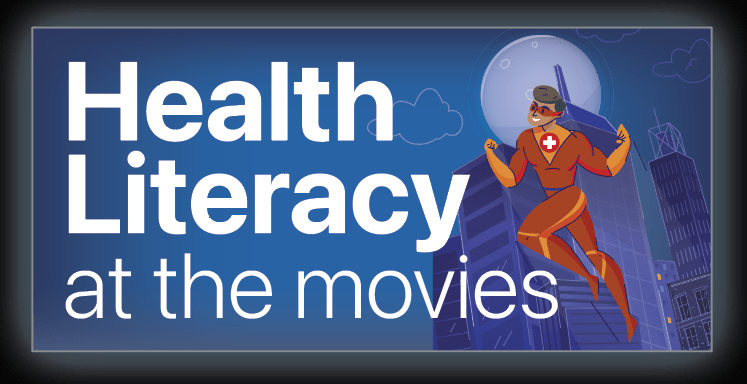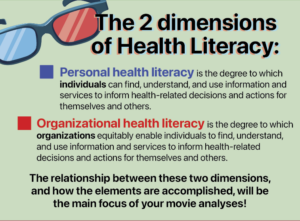Behind the Scenes of Health Literacy at the Movies
By CISCRP Staff|Apr 5, 2023
By CISCRP Staff|Apr 5, 2023

In October, CISCRP’s Health Literacy team worked with a Top 25 pharmaceutical company, to create an infographic celebrating Health Literacy Month, marking the second year of this collaboration. Last year’s materials included an infographic with tips for implementing health literacy best practices and a health literacy crossword puzzle. This year’s infographic contains an exercise to help readers brush up on their health literacy knowledge and think about the importance of keeping health literacy front-of-mind.
CISCRP creates many materials designed to improve health literacy, including videos and brochures. While the general education these provide is important, it is also important to understand the concepts behind their creation. In these Health Literacy Month materials, we unpack what health literacy means, how health literacy principles can be put into practice, and who is responsible for facilitating health literacy. Stay tuned for a look behind the scenes at the concepts highlighted in this infographic.
The theme of the infographic is health literacy at the movies. Health literacy issues appear even where we may not think to look for them, like in our favorite movies. For this Health Literacy Month, we challenged readers to notice and consider how health literacy is depicted in their favorite entertainment media.
Films are a great way to engage with health literacy because of the emotional connections created through storytelling. The empathy we feel for characters allows us to engage with health literacy issues more deeply. The separation of the screen provides us with a safe environment to experience health literacy issues along with the characters, while also giving us the opportunity to step back and look at the big picture.
It’s important to remember that health literacy has two dimensions: personal and organizational.
Personal health literacy is the degree to which individuals have the ability to find, understand, and use information and services to inform health-related decisions and actions for themselves and others.
Organizational health literacy is the degree to which organizations equitably enable individuals to find, understand, and use information and services to inform health-related decisions and actions for themselves and others.
In this infographic, we used movies to offer a bird’s-eye view of the intersection between personal and organizational health literacy in the lives of characters onscreen. This infographic focuses on a few key concepts related to health literacy: decision making, organizational health literacy, and health equity. Each of these concepts is the focus of a different part of the exercise, chosen to encourage health professionals to think about health literacy as a shared responsibility between individuals and organizations.
For this exercise, readers are asked to pick a health literacy issue faced by a character in any movie , whether it is part of the main plot or a small moment. We encourage the audience to engage with health literacy through the entertainment that is interesting to them, whether that means identifying an issue faced by an action hero, sitcom character, or dramatic lead. We designed this exercise to work for any situation, from a character’s cancer treatment to an accidental injury or misuse of medication.
In the first part of this exercise, we highlighted the ability to use information and services to make health-related decisions. Conversations about health literacy often focus on readability and understanding, but the ability to use information and services to make decisions is just as important.
The second part of this exercise asks readers to think about whether the narrative they’ve chosen acknowledges the impact of both personal and organizational health literacy. It was especially important to spotlight organizational health literacy for industry professionals, to get them thinking about the many different stakeholders that play a part in improving personal health literacy for individuals.
In the third part of this exercise, we highlighted health equity and the social determinants of health. The concept of health equity is necessary for understanding the intersection between personal and organizational health literacy. In order for organizations to facilitate personal health literacy, there must be acknowledgement and understanding of varying needs and barriers across different communities. Efforts to improve health literacy are not benefitted by a one-size-fits-all approach but rather by strategies that improve access and opportunities to those who need it most.

The Health Literacy team at CISCRP enjoyed thinking creatively about how to engage a professional audience in this health literacy exercise. One of the most enjoyable parts of the development process was incorporating movie theater imagery into the visual design to draw the audience in. We particularly enjoyed the creation of a health literacy superhero and the visual pun evoking 3D movie glasses that we used to introduce the two dimensions of health literacy. These elements are not just about having fun, but also about organizing content into digestible chunks, an important step for supporting health literacy.
Here’s a word from the Senior Director of the pharmaceutical company with their thoughts on Health Literacy at the Movies:
We were delighted to work with CISCRP to create materials for Health Literacy Month. We partnered with CISCRP because of their expertise in health literacy education, their creative approach, and their experience in tailoring materials to specific audiences. Our pharma company is dedicated to supporting health literacy education and awareness throughout our organization, and we look forward to continuing this partnership with future educational materials.
At CISCRP, it is always our goal to create materials that encourage education. We designed this health literacy refresher to get health professionals to think about health literacy in new ways, both by encouraging them to notice the influences of health literacy all around them and to think about the intersection of personal and organizational health literacy. In this way, the next time they’re at the movies or even catching up on their favorite show, they might think about their organization’s role in health literacy, health equity, and individuals’ agency—not only that of their favorite characters, but of people in our world, too.
Written by: Nina Treese